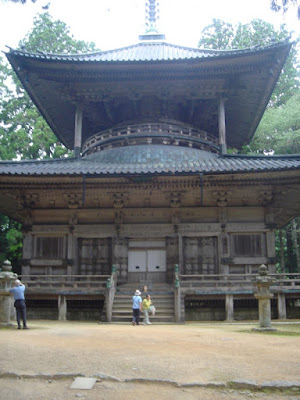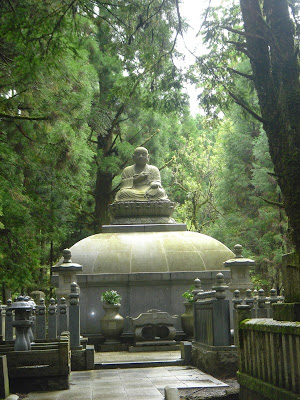Nearly 1200 years ago, a young Japanese man named Kukai traveled to China to study Buddhism. Kukai spent two years in a monestary. His master became deathly ill, and on his deathbed he asked the young monk to return to Japan, and spread his teachings. Kukai returned to Japan and founded the town of
Koyasan in 816 AD.
 A rock garden at Kongobuji temple
A rock garden at Kongobuji templeTisha and I recently took a three day trip to the mountains south of Osaka to visit this beautiful town. Like many westerners, I am quite unfamiliar with Buddhism, and so this trip was particularly fascinating. During our visit we saw many Bhuddist Temples, and a beautiful cemetery. We also took a lovely hike, and stayed overnight at a temple.
(In order to maintain some semblance of brevity, I'm just going to run down the highlights of our action packed trip)
Funicular: The Ascent
Just getting to Koyasan is an adventure in itself. After a few hours and a few transfers on the train we finally arrived at the mountains south of Osaka. Koyasan sits in a valley amongst these mountains, at a height of 3000 feet. The final stretch of our journey was far to steep for mere trains... this, as we all know, was a job for a funicular!
Riding the funicular, feelin' the flow.
After the excitement of the funicular, we needed to simmer down. Fortunately we still had a short bus ride into Koyasan.
Temples
We were finally in Koyasan, and it wasn't long before we got some sweet Buddhist temple action. If you're looking for temples in Japan, then Koyasan is the place to go. There are small temples...

...big Temples...

...and stone temples...
 There's the pilot on top.
There's the pilot on top.
The most impressive temples are at the temple complex of Danjogaran. As always, our Lonely Planet guide gave us the lowdown:
And here he is!
We liked Danjogaran so much, we decided to toss the old pie plate a few times:
Filming your sweet trailing edge catch: priceless
Lodging
We spent our first night in Koyasan at a hostel, which was affordable and nice. Our second night in town we spent at Henjoson-in. Henjoson-in is one of many temples in Koyasan which offers shukubo style lodging to religious pilgrims (and tourists). The staff of these temples are all young Buddhist monks, who earn their keep by running the establishment. Shukubo provides a very authentic experience which includes distinctive vegetarian meals and morning prayer service. Henjoson-in also featured men's and women's Japanese baths, which were quite extravagant. Of course, this was Tisha's favorite part of the trip, and even I must admit that I enjoyed them, despite my well-known aversion to bathing. For photos of Henjoson-in, see the slideshow at the end of the post.
I See Dead People
For our final day in Koyasan, Tisha and I visited the town cemetery, which is located in the forest east of town. This cemetery is actually the main attraction in Koyasan, especially for the religious pilgrims. The most striking feature of the cemetery is its forest setting. Many of the cemeteries I have visited or seen in America are devoid of trees. None of them come close to presenting a native ecosystem, which is what is exactly what has been done in the Koyasan cemetery. I am particularly fond of forests because they are so alive. Walking through this place reminded me of the strong links between life and death. The fallen logs, gravestones, wandering children, and young saplings illustrate that without death there would be no room for new life.

I also realized in this hallowed setting that without mosquitoes there would be no need for bug spray. Fortunately, Tisha was prepared as always.
He is The One
The Buddhists actually believe that one guy has been holding on to his spot in the universe for almost 1200 years, and may not ever give it up. That man is Kukai himself, and at the far end of the cemetery there is small, and I suppose ancient, temple where he's been chillin' like a villain all this time. Of course, nobody gets within 100 meters of Kukai's final dwelling, and photographs are strictly forbidden. That said, Tisha loves candles, and has no shame:
 Sadly, my wife will be reincarnated as a meal worm
Sadly, my wife will be reincarnated as a meal worm
I've Seen Enough to Know I've seen Enough
After seeing Kukai's mausoleum, we weren't exactly sure what to do next. Then we saw this...
 Forget about Iran! The Buddhists have ICBM's!
Forget about Iran! The Buddhists have ICBM's!
... and we knew it was time to go home. As sad as we were to leave Koyasan, we knew we had one more thing to look forward to...
Funicular 2: The Descent
Those poor suffering soy beans
A near miss
Slideshow
